http://www.rhci-online.net/radiogram/radiogram.htm
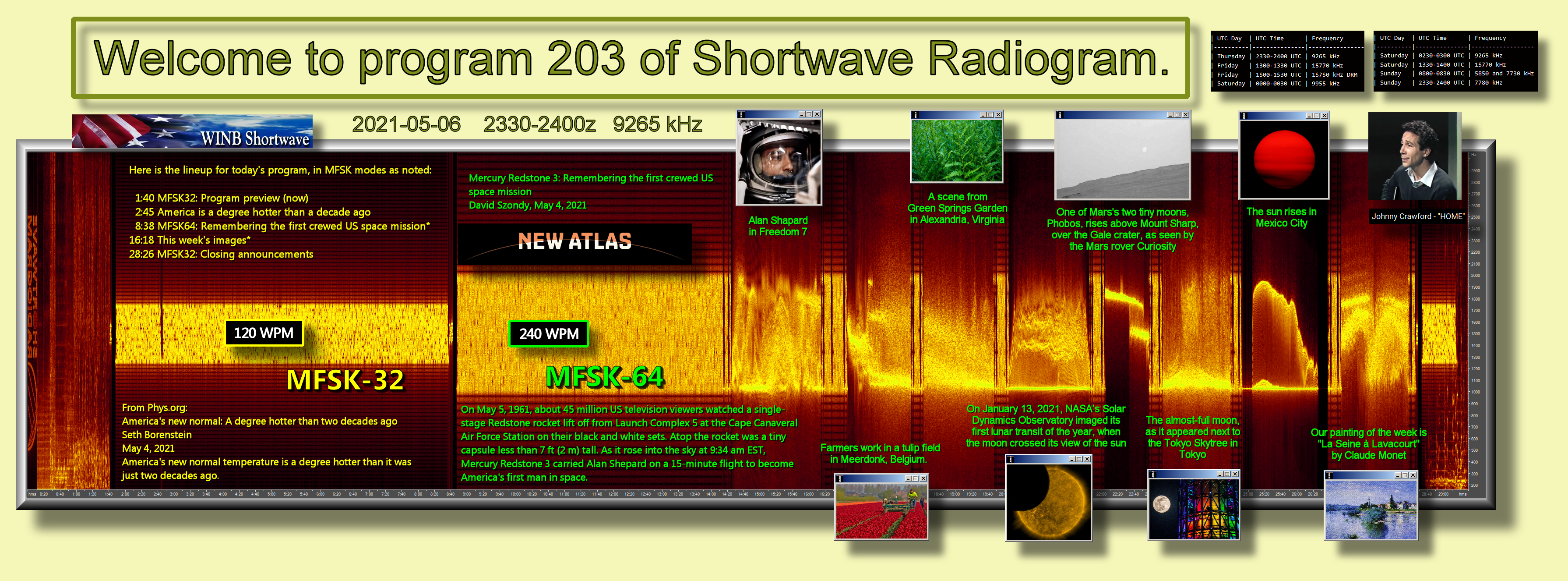
http://www.rhci-online.net/radiogram/radiogram.htm

RSID: <<2021-05-06T23:31Z
MFSK-32 @
9265000+1500>>
Welcome to program 203 of Shortwave Radiogram.
I'm Kim Andrew Elliott in Arlington, Virginia USA.
Here is the lineup for today's program, in MFSK modes as noted:
1:40 MFSK32: Program preview (now)
2:45 America is a degree hotter than a decade ago
8:38 MFSK64: Remembering the first crewed US space mission*
16:18 This week's images*
28:26 MFSK32: Closing announcements
* with image(s)
Please send reception reports to
radiogram@verizon.net
And visit http://swradiogram.net
Twitter: @SWRadiogram
From Phys.org:
America's new normal: A degree hotter than two decades ago
Seth Borenstein
May 4, 2021
America's new normal temperature is a degree hotter than it was
just two decades ago.
Scientists have long talked about climate change—hotter
temperatures, changes in rain and snowfall and more extreme
weather—being the "new normal." Data released Tuesday by the
National Oceanic and Atmospheric Administration put hard figures
on the cliche.
The new United States normal is not just hotter, but wetter in
the eastern and central parts of the nation and considerably
drier in the West than just a decade earlier.
Meteorologists calculate climate normals based on 30 years of
data to limit the random swings of daily weather. It's a standard
set by the World Meteorological Organization. Every 10 years,
NOAA updates normal for the country as a whole, states and
cities—by year, month and season.
For the entire nation, the yearly normal temperature is now 53.3
degrees (11.8 degrees Celsius) based on weather station data from
1991 to 2020, nearly half a degree warmer than a decade ago.
Twenty years ago, normal was 52.3 degrees (11.3 degrees Celsius)
based on data from 1971 to 2000. The average U.S. temperature for
the 20th century was 52 degrees (11.1 degrees Celsius).
The new normal annual U.S. temperature is 1.7 degrees (0.9
Celsius) hotter than the first normal calculated for 1901 to
1930.
"Almost every place in the U.S. has warmed from the 1981 to 2010
normal to the 1991 to 2020 normal," said Michael Palecki, NOAA's
normals project manager.
Fargo, North Dakota, where the new normal is a tenth of a degree
cooler than the old one, is an exception, but more than 90% of
the U.S. has warmer normal temperatures now than 10 years ago,
Palecki said.
In Chicago and Asheville, North Carolina, the new yearly normal
temperature jumped 1.5 degrees in a decade. Seattle, Atlanta,
Boston and Phoenix had their normal annual temperature rise by at
least half a degree in the last decade.
Charlottesville, Virginia, saw the biggest jump in normal
temperatures among 739 major weather stations. Other large
changes were in California, Texas, Virginia, Indiana, Arizona,
Oregon, Arkansas, Maryland, Florida, North Carolina and Alaska.
New normals are warmer because the burning of fossil fuels is
making the last decade "a much hotter time period for much of the
globe than the decades" before, said Cornell University climate
scientist Natalie Mahowald.
For Phoenix, the biggest change in normal came in precipitation.
The normal annual rainfall for Phoenix dropped 10% down to 7.2
inches (18.2 centimeters). Rainfall in Los Angeles dropped 4.6%.
At the same time, Asheville saw a nearly 9% increase in rainfall,
while New York City's rainfall rose 6%. Seattle's normal is 5%
wetter than it used to be.
Climate scientists are split about how useful or misleading newly
calculated normals are.
Mahowald and University of Oklahoma meteorology professor Jason
Furtado said updating normal calculations helps city and regional
planners to prepare for flooding and drought, farmers to decide
what and when to plant, energy companies to meet changing demands
and doctors to tackle public health issues arising from climate
change.
But Pennsylvania State University climate scientist Michael Mann
said he prefers a constant baseline such as 1951 to 1980, which
is what NASA uses. Adjusting normal every 10 years "perverts the
meaning of 'normal' and 'normalizes' away climate change," he
said in an email.
North Carolina's state climatologist Kathie Dello said, "It seems
odd to still call them normals because 1991-2020 was anything but
normal climate-wise."
https://phys.org/news/2021-05-america-degree-hotter-decades.html
Shortwave Radiogram changes to MFSK64 ...
RSID: <<2021-05-06T23:39Z
MFSK-64 @
9265000+1500>>
This is Shortwave Radiogram in MFSK64
Please send your reception report to
radiogram@verizon.net
Mercury Redstone 3: Remembering the first crewed US space mission
David Szondy
May 4, 2021
On May 5, 1961, about 45 million US television viewers watched a
single-stage Redstone rocket lift off from Launch Complex 5 at
the Cape Canaveral Air Force Station on their black and white
sets. Atop the rocket was a tiny capsule less than 7 ft (2 m)
tall. As it rose into the sky at 9:34 am EST, Mercury Redstone 3
carried Alan Shepard on a 15-minute flight to become America's
first man in space.
When the news broke on April 12, 1961, that Russian cosmonaut
Yuri Gagarin aboard Vostok 1 had successfully orbited the Earth
for the first time, one person who reacted with anger and
disappointment was Alan Shepard. One of the famous Mercury 7
astronauts selected to fly America's first crewed spacecraft, he
had trained hard for 21 weeks and claimed the top spot to be the
first person in history to enter outer space, only to end up
being relegated to second place. Worse, Gagarin had orbited the
Earth while Shepard was only going on a sub-orbital flight before
a splashdown in the Atlantic.
For Shepard, this was a particular blow because the Mercury
project had faced many delays in its first three years, including
an Atlas rocket exploding after less than a minute in flight and
a Redstone booster only rising about 4 ft (1 m) from the pad
before coming to rest again on its tail as the engine cut out.
It was bad enough that these setbacks occurred fully in the
public eye due to NASA's policy of complete transparency, but
Shepard also had to bear his frustrations in a mixed atmosphere
of adulation and derision. On the one hand, he, along with Gus
Grissom, Gordon Cooper, Wally Schirra, Deke Slayton, John Glenn,
and Scott Carpenter, became instant heroes the moment they were
introduced to the world as the first US astronauts. On the other,
the test pilots of the American X-15 space plane project jeered
that the Mercury 7 weren't pilots, but guinea pigs, or "Spam in a
can."
It didn't help that Shepard may have been slated to be the first
man in space, but he wasn't the first American. In January 1961,
that honor was given to a chimpanzee named Ham, and who could
take pride in doing a job that a monkey could already handle?
Not that the astronauts took this lying down. Unlike their
Russian counterparts, they were already well versed in the
concepts of spaceflight, and they were not only expected to be
completely briefed on their craft and the support systems, they
were also expected to supervise the construction of the Mercury
capsules and make suggestions for improvements.
In fact, they not only made suggestions, they made demands. On
the grounds that they were pilots and the captains of their
ships, not trained chimpanzees, they expected to fly their
"spacecraft" (not "capsules"). They wanted a window, a hatch they
could open themselves from the inside, and flight controls. At
one point, they even demanded to be able to manually fly the
launch vehicle using aircraft-style controls with a joystick and
pedals. The last request wasn't possible, but they were given
manual overrides to initiate or abort launch sequences if the
autopilot failed.
Unfortunately, Freedom 7, as Shepard christened his spacecraft,
was too far along for these modifications, so his view of space
and the Earth would be through a periscope and two tiny
portholes. He chose the name Freedom 7 because it was capsule no.
7, riding booster no. 7, and there were seven astronauts.
"What better name or call-sign could I choose than Freedom 7?"
asked Shepard.
The launch on May 5 came after several delays due to bad weather,
and even after Shepard entered the capsule there were long waits.
At T-minus 15 minutes, one of the IBM 7090 computers at the
Goddard Space Flight Center developed an error and required a
recheck run, resulting in a two-hour hold. In all, the countdown
took four hours and 14 minutes with Shepard sitting in the
capsule. At three hours, Shepard asked permission to urinate in
his suit. When permission was denied, he went ahead anyway.
Fortunately, the oxygen flow in the suit soon dried him out.
Meanwhile, unlike Vostok 1, which lifted off in a shroud of
secrecy, Mercury Redstone 3 was being watched in person by
hundreds of reporters and by millions worldwide via television
broadcasts. Given that this was more than an adventure, but a
counter thrust in the Cold War, the stakes were very high. One
blessing in disguise was that Gagarin's flight removed many of
the medical fears for Shepard's safety while in space.
For Shepard, the flight of Mercury Redstone 3 had a strange feel
to it. He'd not only trained, he'd over-trained to the point
where his every response was a reflex action. When the countdown
reached zero and the booster roared into life, it seemed to him
like he was back in the centrifuge, except the rocket vibrated
and didn't knock him around like the simulation.
Two minutes and 20 seconds into the flight, the rocket shut down,
and two seconds later the escape tower jettisoned. At two minutes
and 24 seconds, the capsule separated from the booster as small
rockets fired to push them apart. Eleven seconds after that, the
autopilot turned the capsule so it was flying backwards behind
the all-important heat shield.
Unlike later missions, which were marked by systems checks and
other business, Shepard was already a third of the way through
his suborbital flight at the five-minute mark, reaching an
altitude of 115 miles (185 km) while only 150 miles (240 km)
downrange of Cape Canaveral. At this point, Shepard took manual
control of the craft, firing the pitch, yaw, and roll thrusters
to demonstrate that he could control its attitude. He then
switched back to automatic and maneuvered the craft using the
fly-by-wire controls.
At five minutes and 15 seconds, the retrorocket pack fired for 10
seconds, slowing Freedom 7 for controlled reentry. The pack was
then jettisoned, leaving the heat shield bare. As the craft
descended, Shepard tried to see the stars through the tiny
portholes, but it turned out that they aren't as visible to the
naked eye as was thought. He was also falling behind on his to-do
list and was feeling both time and gravitational pressures as the
seconds ticked by and acceleration rose to 11.6 g.
A mere 10 minutes into the flight. The main parachute deployed
and Freedom 7 drifted down to the recovery area in the North
Atlantic off the Bahamas for splashdown. The entire mission
lasted 15 minutes and 22 seconds and Shepard ended up only 303
miles (487 km) from where he'd started.
By today's standards, Mercury Redstone 3 was a very simple
suborbital mission, but in 1961 it was proof that the United
States had mastered the technology to send a human being safely
into space. The transparency of the mission, being carried out
live on television for all to see, also led to the public
skepticism about the Soviet orbital mission, which was carried
out in absolute secrecy and which the Soviets lied about for
years afterwards. But most important, Mercury Redstone 3 was the
first step that would lead to the first footprint on the Moon in
eight short years.
https://newatlas.com/space/mercury-redstone-3-60-year-anniversary-first-us-crewed-space-mission/
Image: Alan Shapard in Freedom 7 ...
Sending Pic:189x193C;
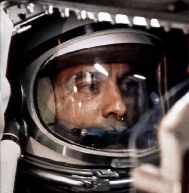
This is Shortwave Radiogram in MFSK64
Please send your reception report to
radiogram@verizon.net
This week's images ...
Farmers work in a tulip field in Meerdonk, Belgium. Most tulips
in the region are grown specifically for the bulbs and not the
flowers, however the flowers remain in the fields until fully
blossomed before being cut down.
https://bit.ly/33hvJE5 ...
Sending Pic:207x125C;

A scene from Green Springs Garden in Alexandria, Virginia, May 1.
https://wapo.st/3h4M32S ...
Sending Pic:205x140C;

On January 13, 2021, NASA’s Solar Dynamics Observatory imaged its
first lunar transit of the year, when the moon crossed its view
of the sun.
https://bit.ly/3vDaNDA ...
Sending Pic:191x172C;
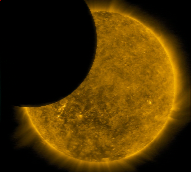
One of Mars's two tiny moons, Phobos, rises above Mount Sharp,
over the Gale crater, as seen by the Mars rover Curiosity, March
19, 2021.
https://bit.ly/3vDaNDA ...
Sending Pic:303x179;
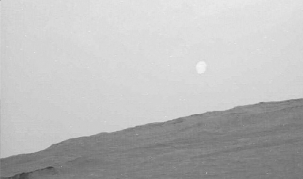
The almost-full moon, as it appeared next to the Tokyo Skytree in
Tokyo, April 26.
https://bit.ly/33kKKVA ...
Sending Pic:204x136C;
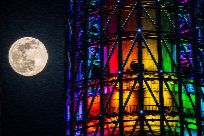
The sun rises in Mexico City, April 26.
https://bit.ly/33kKKVA
...
Sending Pic:200x176C;

Our painting of the week is "La Seine à Lavacourt" by Claude
Monet. https://bit.ly/3vK9K4B ...
Sending Pic:207x133C;

Shortwave Radiogram returns to MFSK32 ...
RSID: <<2021-05-06T23:58Z
MFSK-32 @
9265000+1500>>
This is Shortwave Radiogram in MFSK32 ...
Shortwave Radiogram is transmitted
by:
WRMI, Radio Miami International, wrmi.net
and
WINB Shortwave, winb.com
Please send reception reports to
radiogram@verizon.net
And visit http://swradiogram.net
Twitter:
@SWRadiogram or twitter.com/swradiogram
I'm Kim Elliott. Please join us for the next Shortwave
Radiogram.
|
SWRG#203 closing song: Johnny Crawford - "HOME"https://de.wikipedia.org/wiki/Johnny_Crawford https://en.wikipedia.org/wiki/Johnny_Crawford John Ernest Crawford; * March 26, 1946 in Los Angeles, California; † 29. April 2021)
|

http://www.rhci-online.net/radiogram/radiogram.htm
|
QTH: |
D-06193 Petersberg (Germany/Germania) |
|
|
Ant.: |
Dipol for 40m-Band & Boomerang Antenna 11m-Band |
|
|
RX for RF: |
FRG-100B + IF-mixer & ICOM IC-R75 + IF-mixer |
|
|
Software IF: |
con STUDIO1 - Software italiano per SDR [S-AM-USB/LSB] + beta 11 Version 2.80 (August 21, 2018) - for scheduled IF-recording |
|
|
Software AF: |
Fldigi-4.0.18 + flmsg-4.0.7 images-fldigifiles on homedrive.lnk |
|
|
OS: |
German XP-SP3 with support for asian languages |
German W7 32bit + 64bit |
|
PC: |
MEDION Titanium 8008 (since 2003) [ P4 - 2,6 GHz] |
MSI-CR70-2MP345W7 (since2014) [i5 -P3560 ( 2 x 2,6GHz) ] |
http://wiki.radioreference.com/index.php/Decoding_the_SW_Radiogram_Broadcasts
https://www.qsl.net/ve7vv/Files/Digital%20Modes.pdf


This Is A Music Show #114
06 May 2021
0200-0300UTC Thursday on 5850 kHz
via WRMI, Okeechobee USA
***ALSO***
TIAnExpressMS w/ Radio Northern Europe International
via Channel 292 in Germany, on 6070 kHz.
Broadcast various dates/times. Check the schedule here:
https://www.channel292.de/schedule-6070-khz/
https://rnei.org/
----------------------------------------
PLAYLIST
George Barnes - Tiger Rag
-----
Roy Etzel And His Band - Paranoid
The Projection Company - Uh Uh Uh
Polly Brown - Saving All My Love
-----
B.T. Express - Do It Till You're Satisfied
T-Connection - Groove To Get Down
Tom Browne - Thighs High
Skyy - Here's To You
-----
Portland All Stars - Portland Rock Pt. 3
The Cables - Be A Man
-----
Cabaret Voltaire - Sensoria
Yaz - Situation
Gang Of Four - Is It Love
-----
Flowers And Alvin - Howdy and Tenky
-----
THIS DATA w/ Bert Kaempfert - Two On A Tune
-----
The Intruders - Friends No More
----------------------------------------
TIAMS Website:
https://thisisamusicshow.com
Go here for show archives + official shop!
-----
Please send reception reports/comments:
thisisamusicshow@gmail.com
Follow TIAMS on Twitter:
www.twitter.com/ThisIsAMusicSho/
------
Thanks for listening!
--YOUR HOST--
EOM
Sending Pic:300x300Cp4;
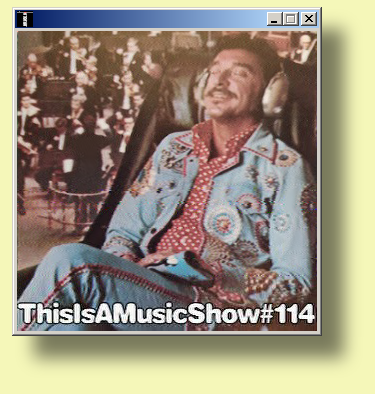
RSID: <<2021-05-09T01:30Z MFSK-64 @ 9925000+1500>>
Rick Nelson (Ricky) was born Eric
Hilliard Nelson, May 8, 1940.
He died in 1985.
Sending Pic:209x216;
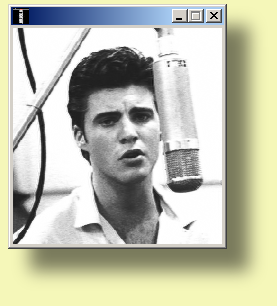
bit.ly/3xFugoS
Please report your decode to
themightykbc@gmail.com

http://www.nirfi.unn.ru/nirfi-news/sura-snova-v-efire-super-ivent-posvyashhennyj-dnyu-radio/
5227 kHz
http://www.nirfi.unn.ru/nirfi-news/chastota-vyhoda-v-efir-stenda-sura-v-den-radio/
Частота выхода в эфир стенда СУРА в День радио!
07 мая 2021
Частота выхода в эфир стенда СУРА 07.05.2021г. – 5227 кГц.
|

4300 kHz
http://www.nirfi.unn.ru/nirfi-news/vazhno-smena-chastoty-vyhoda-v-efir-stenda-sura-v-den-radio/
Важно! Смена частоты выхода в эфир стенда СУРА в День радио!
07 мая 2021
Частота выхода в эфир стенда СУРА 07.05.2021г. в 16:00 – 4300 кГц.
|
